
On Sunday March 20th, 1977 the Central Electricity Generating Board disconnected Portsmouth's contribution to the National Grid, thus ending 83 years of involvement in the business of electricity generation.
It was at a meeting of the Portsmouth Town Council on November 9th 1889 that the first steps towards a local generation of electricity was determined by the appointment of a lighting committee to be chaired by Alderman George Ellis. So Portsmouth became the first Municipal Corporation to establish its own turbo-alternator generating system. In 1892 the Board of Trade approved the decision to establish a 200 volt AC single phase system and work began on the building of a power station with the laying of a foundation stone by the Mayor, Alderman T. Scott Foster.
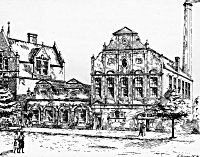
The site chosen for the station was in St Mary Street, Old Portsmouth, for which the Blue Bell Tavern and the South of England Music Hall along with a number of houses were demolished. The site was chosen principally for it's proximity to the Camber allowing the easy import of coal for the boilers.
The machinery was designed and installed by the Ferranti company under the energetic leadership of Dr. Sebastian Ziani de Ferranti, familiarly known as Basti. With the shell of the building completed early in 1894 Ferranti moved his family to Southsea on March 20th and stayed until June 22nd. The work was intense, frequently continuing until after midnight, but by June 6th all was ready for the switch on which caused enough excitement to draw engineers from London to witness the event. The ceremony was conducted by the Mayor AL Emanuel and the Mayoress who switched on the Ferranti dynamos and so bathe the building in incandescent light.
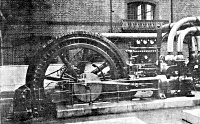
Later the Mayor held a banquet during which Basti was called back to the station where an exceptionally low tide was threatening the supply of sea water to cool the engines. Luckily disaster was averted and Basti was able to return to the feast.
The plant installed at the station consisted of two 200kW alternators coupled direct to low speed engines. The combined output was 550kW and the steam was provided by five Lancashire boilers each having a steaming capacity of 5000lbs. From the outset, the project proved to be wildly successful with demand increasing exponentially. Within just two years of opening the plant the Electric committe were recommending that a further 200kW generator be installed and by the time of World War I the output had reached 3,300kW.
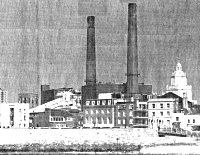
There was an inevitable lull in demand during the war but by 1920 a further 2,500 kW had been added and it was plain that the existing premises would soon become inadequate. The first stage of this expansion occurred in 1927 when the existing site was extended to accommodate the first 10,000kW machine, the new building being opened by the Mayor Councillor Frank J. Privett on January 12th. A second similarly sized generator was installed two years later. At the same time the Camber Dock was opened for colliers to deliver the coal right to the door of the station.
Expansion of the plant continued, taking over the sites of Portsmouth Town School, St Mary's Church and the Colewort Barracks, until it occupied the whole plot between Gunwharf Road, St George's Road and Warblington Street. Two 300ft chimneys appeared, providing one of the most recognisable features of the Portsmouth skyline.
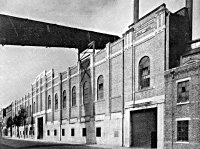
By this time the Portsmouth Station had been incorporated into the new nationalised British Electricity Authority and was pumping electricity into the National Grid. In 1955 it contributed 475,901,000 units of electricity. Some other statistics serve to illustrate the scale of the operation. At it's peak the station was drawing 6.6 million gallons of sea water per hour from the Camber for condensing purposes; it's own colliers, "Pompey Power" and "Pompey Light" delivered 172,000 tons of coal a year for the 13 boilers; the main turbine hall when re-built had dimensions of 429'x65'x48' high and utilised over 1 million bricks; the ash bunkers held a maximum of 600 tons of dry ash.
Astonishing though some of these statistics are they could not disguise the fact that technology was moving on and by 1977 the CEGB had declared that the Portsmouth Generating Station was surplus to requirements. The chimneys were demolished, brick by brick, in 1981 and the main buildings had vanished by 1983 to be replaced shortly afterwards by about 170 residential units.
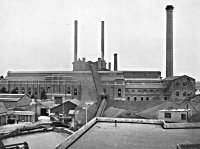
A postscript to the story of the Power Station was provided by the archaeologists who moved onto the site following the demolition of the main buildings. In one pit they found hundreds of 17C bottles and pottery, plus human bones, possibly from a plague pit and many clay pipes probably thrown away by soldiers at the Colewort Barracks. A further revelation occurred when the original Power Station foundation stone was unearthed. It was found to contain a time capsule, buried in the stone in 1892, in the form of a glass jar packed with newspapers and two scrolls, one of which had been placed there when the capsule had been recovered during re-building work in 1927. Two plaques commemorating both the original construction and the 1927 upgrade have since been placed into a wall in Armory Lane and the capsule is said to be buried within.
REFERENCES
"The Portsmouth that has Passed" by William Gates
Publications of the Electricity Committee, 1938 and 1944
"The Life and Letters of Sebastien Ziani de Ferranti" by his wife Gertrude and Richard Ince (1934)
The News, March 21 1977, October 1 1984 and September 18, 1985